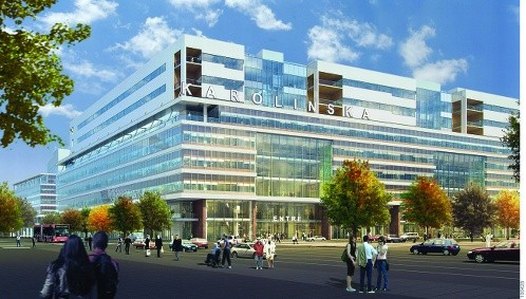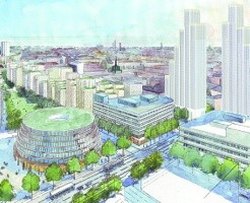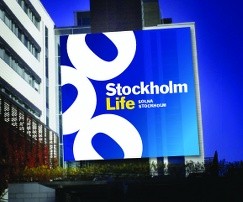
A living city – The Norra Station/Karolinska area, as projected in 2025 (Illustration: Brunnberg & Forshed/Claudius)
The Stockholm/Uppsala region, in particular, represents 54% of the country's life science strength and as many as 15 Nobel prizes have been awarded to researchers from the region. But all eyes are now set on even higher ambitions as the region aims to become the world's most attractive centre for life science by 2025. At the centre of all this activity is the Norra Station/Karolinska area, which by 2025 will have about five billion Euro worth in investments and already has a common brand recognition attached and is now referred to as - Stockholm Life Solna -Stockholm.
Though it is based on a concentrated geographical area, Stockholm Life Solna-Stockholm is best described as a phenomenon whose strategy rests on the articulation of the three key partner groups: the academic world, industry and health care providers.
Complementary areas, multiplied knowledge
Stockholm Life Solna - Stockholm is a cross-border project in many ways. Firstly, on a local level, with the Norra Station/Karolinska area being one where the cities of Stockholm and Solna meet.
Secondly, in regional terms, with reference to the strong life science muscle at its core (which stretches north to Uppsala, south to Södertälje and west to Strängnäs) and which is exercised by a high concentration of companies, a qualified workforce and a burgeoning research community.
Thirdly, this is also backed up in terms of political commitment, since the project is supported by the different party blocks in a stable fashion.
And lastly, when it comes to its multi-disciplinarity, in terms of the different knowledge areas whose collaboration is making it real – the academic, industry and health care spheres. Facilitating all these interplays is the Stockholm Science City Foundation, an entity commissioned by the three leading universities Karolinska Institutet, KTH Royal Institute of Technology and Stockholm University as well as the cities of Stockholm and Solna and Stockholm County Council. Its mission is to create meaningful cooperation opportunities between the various stakeholders. This way, the Norra Station/Karolinska area will shine even brighter in the eyes of those involved in life sciences across the world, with brand recognition of Stockholm Life Solna – Stockholm being a guarantee of excellence.
Work underway
When it comes to establishing Stockholm Life Solna - Stockholm as a life science hub, much has already been put in place: within a range of about two-and-a-half kilometres, the area can count three universities, about 47 000 full-time students, 4 000 researchers, a university hospital and 50 to 60 companies with a life science focus.
In 2007, the political powers in both Stockholm and Solna decided to freshen up the area that divided the two cities - and is now destined to unite them. Anyone passing by Norra Station/Karolinska today will note that plenty of activity is already underway. The work to cover the E4/E20 motorway as well as the railway segments has already begun and recently Crown Princess Victoria officiated over the ground-breaking ceremony for the New Karolinska Solna hospital, to be inaugurated in about five years time.
In 2011, the construction of a mall and office spaces by the corner of Solna Bridge and Norra Station Street will begin – as will the construction of one of the two emblematic Tors torn skyscrapers, which is destined to house Life Science-related companies. In the following years up to 2018, the other tower (which will accommodate a hotel) and the Karolinska Institutet's Biomedicum centre will be erected. This new infrastructure will be joined by the construction of a number of new accommodation units.
Soft infrastructure
Despite is clear visibility to the naked eye this construction work does not tell the whole story. In parallel to buildings and public transport, a stark focus is being placed on the so-called "soft infrastructure", i.e. the activities and tools which support the stakeholders in the region so that they can reach their goals faster, by helping the corporate world to boost their gains and/or reduce costs and risks. Such is the added value of Stockholm Life Solna-Stockholm, which facilitates contacts and information and helps the process of "matchmaking" between different partners so that a fruitful collaboration can flourish.
The more plural this information and knowledge transfer (and creation) are, the faster all parties will be able to adjust to the needs of their partners and clients, raising the value of their own products and services along the way. For example, real estate actors at Norra Station/Karolinska are learning about the infrastructural needs of the life science branch, so as to make their property suitable for such business and, hence, more attractive; Stockholm Science City Foundation is working to open the channels so that the medtech industry can better access the Swedish healthcare sector, making the latter more receptive to testing the latest innovative products which are in the pipeline.
The vision of Stockholm Life Solna-Stockholm is that these partner groups are not only closer in space but also share a platform to listen to and express their own ideas and expectations – a process which will grant them an innovation-based competitive advantage.
These cross-sector knowledge dynamics have – already today – a strong expression in the region. By bridging the gaps between the research and the business worlds in a systematic way, these dynamics will become much more meaningful and will, ultimately, make a profound contribution to the way people live.
Each person in the centre
Much of Stockholm Life Solna-Stockholm's value is to focus on the improvement of health and life quality in everyday life in the region. When it comes to healthcare, the New Karolinska Solna university hospital is to operate in a revolutionary way, putting the patient at the centre of gravity of all the different clinical specialties, instead of making him/her transit from one department to another during diagnosis and treatment.
In addition, the North Station/Karolinska area is not an isolated area in the outskirts of the city: it is located one step away from the vibrant urban centre of Stockholm and from the quietness of nature in the Royal National City Park. By 2025, the area will be equipped with not only first-class healthcare facilities, a prosperous business centre and reputed academic institutions, but also with about 5 500 new residential units, schools, cafés, infrastructure for culture and recreation, public transport and other services which will ensure the continuing attractiveness of the area seven days a week, 24 hours a day.

The New Karolinska Solna university hospital ( construction is already underway) (Concept picture: Tengbom/Skanska/Nya Karolinska Solna)

Stockholm Life – Solna Stockholm – the brand which expresses the life science strength of Norra Station/Karolinska
By Ylva Williams, CEO, Stockholm Science City Foundation
The New Karolinska Solna university hospital ( construction is already underway) (Concept picture: Tengbom/Skanska/Nya Karolinska Solna)